Waste Management 2012
6th International Conference on Waste Management and the Environment
4 - 6 July 2012
New Forest, UK
Overview
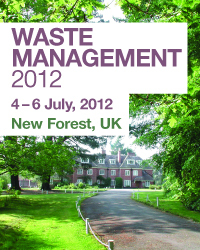
The sixth International Conference on Waste Management and the Environment was held in the New Forest, UK. The conference was organized by the Wessex Institute of Technology with the collaboration of Nagoya University, Japan. This sixth conference follows the success of previous meetings held in Cádiz (2002), Rhodes (2004), Malta (2006), Granada (2008) and Tallinn (2010). The conference provided a forum for the exchange of scientific information and views on the current situation of waste management among professionals, researchers, government representatives and local authorities.
Waste generation is one of the key problems of the modern world due to the vast volumes and variety requiring different management strategies. The desired direction of the waste management is towards sustainable strategies. The approach which emerged as a most sustainable strategy has been called 3Rs, where reduction, reuses and recycling, in this order, are seen as the best actions. Recently a fourth action (4Rs) has been added in order to stress the recovery of energy from waste. This largely decreases the volume of the waste that needs final disposal. However, the sustainable strategies still need to find answers to issues related to environmental and safety aspects of certain recycled materials or by-products of waste management activities. Further steps are required towards improvement of current technologies, increased collaboration between the public, government and private sectors and increased involvement of all stakeholders.
The conference Co-chairmen were Professors Carlos A Brebbia and Viktor Popov from Wessex Institute of Technology and Professor Hideaki Itoh from Raremetal Recovery Institute and until recently Professor at Nagoya University in Japan.
Opening Address
Professor Carlos Brebbia opened the meeting by explaining the importance of the conference papers as part of the main objective of the Institute, ie the dissemination of knowledge. WIT – Carlos explained – undertakes a series of activities, including training and research at PhD level, services to industry, publishing and the organisation of conferences and seminars in different locations around the world. The Institute is renowned throughout the world for its work in advanced computational methods, and has developed a special technique called boundary elements. The applications of this research are wide, ranging from engineering concepts to environmental problems.
Most research carried out at the Institute is in collaboration with other organisations, either through joint projects such as those supported by the EU or link agreements with many institutions around the world.
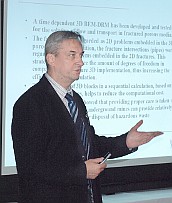
The conference papers – Carlos said – are also archived in the web e-library of the Institute (http://library.witpress.com/) where they are permanently and easily available to the international community.
Authors of conference papers are also encouraged after the meeting to submit extended versions of their papers to the International Journal of Sustainable Development and Planning, one of the publications supported by WIT.
Following Carlos’ address, Prof Viktor Popov gave a short presentation on the work carried out by his Environmental Fluid Mechanics Division in modelling leakages of contaminated materials from nuclear repositories. This major project – supported by the EU – was based on the Boundary Element Method and produced important results to predict the risk of radioactive leakages into the aquifer due to rock movements.
Conference Topics
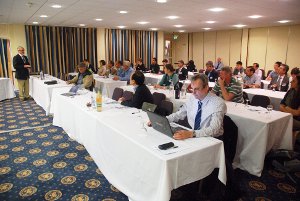
- Cost and benefits of management options
- Waste incineration and gasification
- Industrial waste management
- Environmental impact
- Agricultural waste
- Nuclear and hazardous waste
- Wastewater
- Energy from waste
- Reduce, reuse and recycle (3Rs)
Invited Presentations
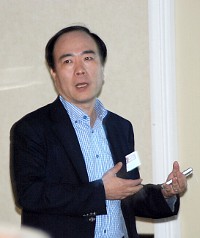
‘Extended producer responsibility (EPR) and job creation in Korea’
by J H Kim, Seo-Kyeong University, South Korea
‘Thermal gasification of agro-industrial residues’
by P S O Brito, Polytechnic Institute of Portalegre, Portugal
‘Analysis of the industrial solid wastes from the boat building sector in Marche Region (Italy): parametrical and chemical-physical’
by F Tatàno, University of Urbino ‘Carlo Bo, Italy
‘Illegal dumping investigation: a new challenge for the forensic environmental engineering’
by M Lega, University of Naples Parthenope, Italy
‘Local environmental impact from MSW aerobic biological treatment’
by E C Rada, University of Trento, Italy
‘Study of the antioxidant potential of several forestry biomass wastes’
by J González-Alvarez, University of Santiago de Compostela, Spain
‘Isolation of hazardous soil contaminated by DU (depleted uranium)’
by R Pusch, Luleå University of Technology, Sweden
‘Energy recovery from unused and expired medicines’
by P De Filippis, University of Rome ‘La Sapienza’, Italy
Social Occasions
The delegates had numerous occasions for informal discussions during the social fixtures that took place during the conference and in the refreshment breaks, which included complimentary lunches, as well as coffee breaks.
They also participated in a lunchtime excursion to one of the most beautiful sites in the New Forest, ie Bucklers Hard, to which they were taken by bus and offered a packed lunch.
Bucklers Hard is a very picturesque village of great historical interest lying on the Beaulieu River. It was a shipbuilding centre, which at its height had five slipways and around 20 cottages for the workers. Only two rows of cottages now remain with a broad village street separating them and sloping towards the river. At the end of one row stands a hotel, which was the Master Builder’s house. An excellent display at the entrance of the village describes the activities that took place there.
Many fine wooden ships were built there including the famous Agamemnon, commanded by Nelson during the siege of Calvi, in which he lost the vision of his right eye. This ship, together with Swiftsure and Euryalus, all built at Buckers Hard, took part in the Battle of Trafalgar.
The delegates were able to walk around the village and visit the pub as well as a tiny chapel located in one of the builders’ cottages.
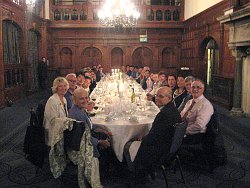
The house has been built in a style loosely resembling a Scottish castle with a series of rooms decorated differently. The dinner took place in the most magnificent of them all, the Great Hall, a hammer-beam style roof, following that of the Old Westminster Hall in the Houses of Parliament.
Before dinner the delegates were guided around the garden by Carlos Brebbia, who showed them the amphitheatre and maze, as well as the water fountain features of the gardens.
Rhinefield House has other attractions, such as its Italianate and French style dining rooms, a beautiful wood panelled restaurant dominated by a carving depicting the defeat of the Spanish Armada and a small room in the style of the Alhambra of Granada.
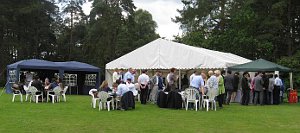
The meal was of excellent standard and the dishes were accompanied by good red and white wines. At the end of the meal Carlos offered each participant a hand made bowl, the work of a local potter. Each bowl was individually decorated. Carlos hoped that the souvenir will remind them of the conference and of the New Forest.
During a lunch break the delegates were taken to the campus of the Wessex Institute, where they were shown some of the buildings. There they also took part in a lamb BBQ which was a friendly social occasion that helped to strengthen the links between them. Many expressed an interest in continuing collaboration with WIT and requesting more information about the Institute. Overall the occasion was friendly and relaxed, with the weather helping to make it unique.
Close of the Conference
Carlos closed the conference by thanking all for coming and for making Waste Management 2012 such a friendly and productive meeting. He explained that oral presentations will appear in subsequent volumes of the Wessex Institute Transactions. He also encouraged all participants to prepare an extended version of their paper for submission to the International Journal of Sustainable Development and Planning and the International Journal of Safety and Security. He finished by inviting all participants to visit the WIT Campus next time they are in the region.
The success of the conference will ensure that it is reconvened in 2014 in a place and date to be shortly decided.
Conference Proceedings
The proceedings of Waste Management, 448pp (Print ISBN:978-1-84564-606-6; eISBN: 978-1-84564-607-3) are available from WIT Press. Orders can be placed on the WIT Press web site at www.witpress.com or by email: This email address is being protected from spambots. You need JavaScript enabled to view it., telephone: +44 (0) 238 029 3223 or fax: +44 (0) 238 029 2853.Papers from the conference will also be hosted online at the WIT eLibrary as Volume 163 of WIT Transactions on Ecology and the Environment ISSN: 1746-448X, Digital ISSN 1743-3541). For more details visit the WIT eLibrary at http://library.witpress.com


 Wessex Institute
Wessex Institute